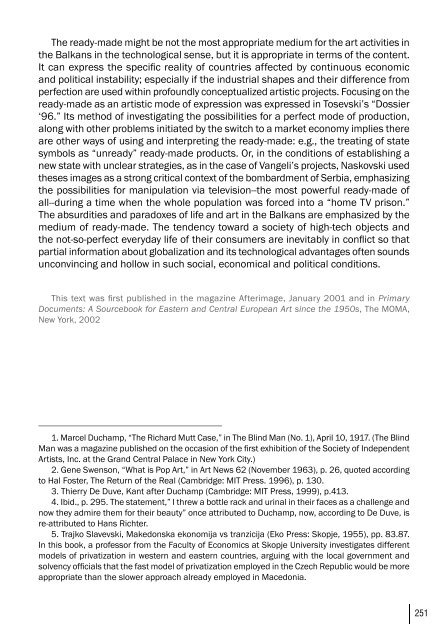art-e-conomy _ reader - marko stamenkovic
art-e-conomy _ reader - marko stamenkovic
art-e-conomy _ reader - marko stamenkovic
Create successful ePaper yourself
Turn your PDF publications into a flip-book with our unique Google optimized e-Paper software.
The ready-made might be not the most appropriate medium for the <strong>art</strong> activities in<br />
the Balkans in the technological sense, but it is appropriate in terms of the content.<br />
It can express the specific reality of countries affected by continuous economic<br />
and political instability; especially if the industrial shapes and their difference from<br />
perfection are used within profoundly conceptualized <strong>art</strong>istic projects. Focusing on the<br />
ready-made as an <strong>art</strong>istic mode of expression was expressed in Tosevski’s “Dossier<br />
‘96.” Its method of investigating the possibilities for a perfect mode of production,<br />
along with other problems initiated by the switch to a market e<strong>conomy</strong> implies there<br />
are other ways of using and interpreting the ready-made: e.g., the treating of state<br />
symbols as “unready” ready-made products. Or, in the conditions of establishing a<br />
new state with unclear strategies, as in the case of Vangeli’s projects, Naskovski used<br />
theses images as a strong critical context of the bombardment of Serbia, emphasizing<br />
the possibilities for manipulation via television--the most powerful ready-made of<br />
all--during a time when the whole population was forced into a “home TV prison.”<br />
The absurdities and paradoxes of life and <strong>art</strong> in the Balkans are emphasized by the<br />
medium of ready-made. The tendency toward a society of high-tech objects and<br />
the not-so-perfect everyday life of their consumers are inevitably in conflict so that<br />
p<strong>art</strong>ial information about globalization and its technological advantages often sounds<br />
unconvincing and hollow in such social, economical and political conditions.<br />
This text was first published in the magazine Afterimage, January 2001 and in Primary<br />
Documents: A Sourcebook for Eastern and Central European Art since the 1950s, The MOMA,<br />
New York, 2002<br />
1. Marcel Duchamp, “The Richard Mutt Case,” in The Blind Man (No. 1), April 10, 1917. (The Blind<br />
Man was a magazine published on the occasion of the first exhibition of the Society of Independent<br />
Artists, Inc. at the Grand Central Palace in New York City.)<br />
2. Gene Swenson, “What is Pop Art,” in Art News 62 (November 1963), p. 26, quoted according<br />
to Hal Foster, The Return of the Real (Cambridge: MIT Press. 1996), p. 130.<br />
3. Thierry De Duve, Kant after Duchamp (Cambridge: MIT Press, 1999), p.413.<br />
4. Ibid., p. 295. The statement,” I threw a bottle rack and urinal in their faces as a challenge and<br />
now they admire them for their beauty” once attributed to Duchamp, now, according to De Duve, is<br />
re-attributed to Hans Richter.<br />
5. Trajko Slavevski, Makedonska ekonomija vs tranzicija (Eko Press: Skopje, 1955), pp. 83.87.<br />
In this book, a professor from the Faculty of Economics at Skopje University investigates different<br />
models of privatization in western and eastern countries, arguing with the local government and<br />
solvency officials that the fast model of privatization employed in the Czech Republic would be more<br />
appropriate than the slower approach already employed in Macedonia.<br />
251


